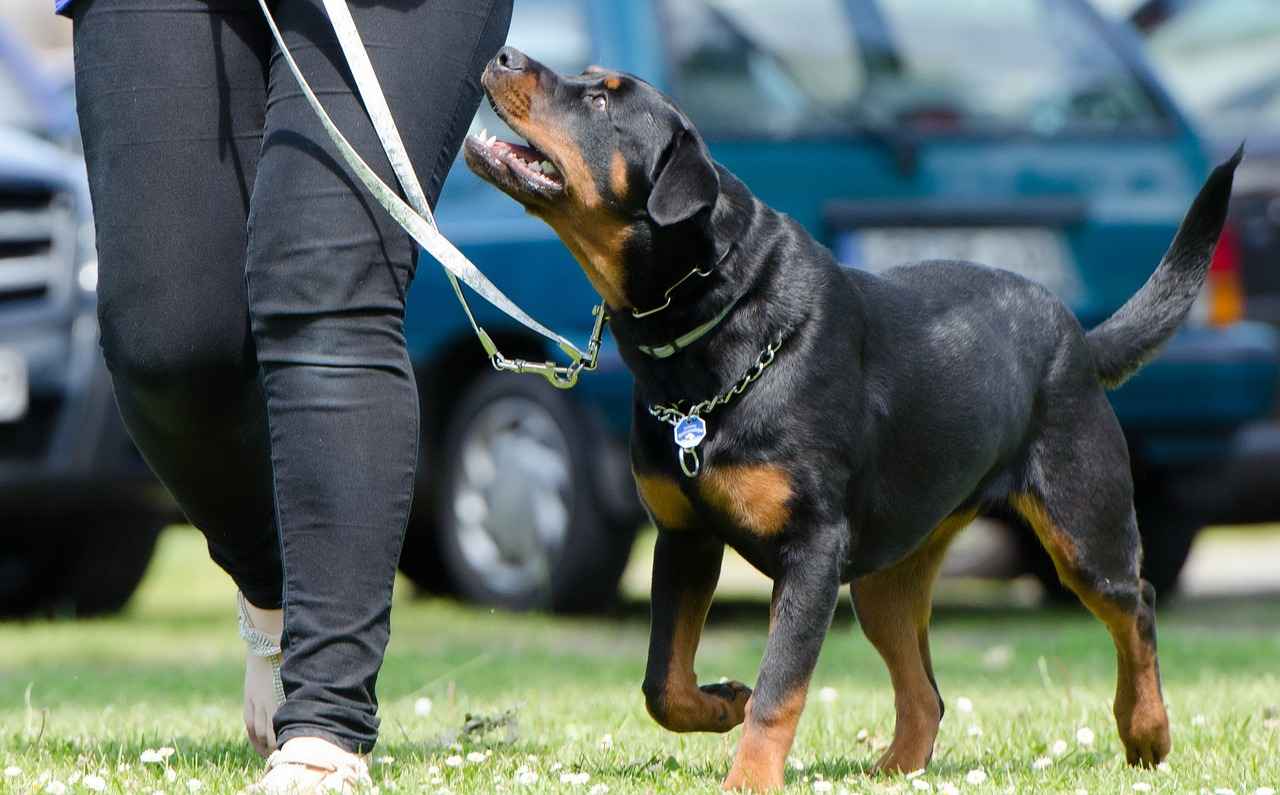This article delves into the remarkable bite force of Rottweilers, shedding light on their physical capabilities, historical significance, and the implications for responsible ownership and training. Recognizing the strength of a Rottweiler is essential for potential owners to ensure a safe and harmonious relationship with their pet.
Understanding Dog Bite Force
Dog bite force is quantified in pounds per square inch (PSI), serving as a critical indicator of a dog’s strength and potential aggression. This measurement is vital in understanding canine behavior and ensuring safe interactions between dogs and humans.
Rottweiler Bite Force Measurement
The Rottweiler boasts an impressive bite force estimated at approximately 328 PSI, positioning it among the strongest dog breeds. This powerful bite force not only highlights their physical strength but also reflects their innate protective instincts, which have been honed over generations.
Factors Influencing Bite Force
- Breed: Different breeds exhibit varying bite strengths.
- Size: Larger dogs often have stronger bites.
- Jaw Structure: The anatomy of a dog’s jaw plays a crucial role in its biting capability.
Training and Behavior
Proper training is essential for managing a Rottweiler’s bite force. With effective training techniques, owners can mitigate aggressive tendencies and promote positive behaviors, ensuring safe interactions with both humans and other animals.
Historical Background of Rottweilers
Originally bred as working dogs for herding and guarding livestock, Rottweilers have a rich history. Their strong bite force was indispensable for their roles in protection and herding, showcasing their capability as both guardians and companions.
Rottweilers as Family Pets
Despite their formidable bite strength, Rottweilers can be affectionate and loyal family pets when properly trained and socialized. Understanding their capabilities and needs is crucial for responsible pet ownership.
Implications for Rottweiler Owners
Owning a Rottweiler necessitates a commitment to ongoing training and socialization. Owners must be prepared to invest time and effort into their dog’s development to ensure a safe environment for everyone.
Conclusion: Understanding Rottweiler Bite Force
In conclusion, the Rottweiler’s impressive bite force is a testament to its strength and capabilities. Responsible ownership, consistent training, and proper socialization are key factors in ensuring that these powerful dogs are safe and well-adjusted companions.

Understanding Dog Bite Force
is an essential aspect of canine behavior that pet owners and trainers should be aware of. Dog bite force is quantified in pounds per square inch (PSI) and serves as a critical indicator of a dog’s potential aggression and physical strength. By comprehending this measurement, we can better understand the dynamics of dog behavior and ensure safe interactions between dogs and humans.
The concept of bite force is not just a number; it reflects the power that a dog can exert when biting. This metric can significantly impact various aspects of dog ownership, including training, socialization, and safety protocols. For instance, breeds known for their high bite force, such as Rottweilers, Pit Bulls, and German Shepherds, require specialized training to manage their strength effectively.
Research indicates that the average dog has a bite force ranging from 200 to 400 PSI, with larger breeds typically exhibiting stronger forces. Understanding these figures allows owners to gauge the potential risks and responsibilities associated with different breeds. It also underscores the importance of proper training and socialization, which can help mitigate aggressive tendencies and promote positive behavior.
- Training: Consistent and positive reinforcement training is crucial for managing a dog’s behavior and bite force.
- Socialization: Early exposure to various environments and people can help reduce fear and aggression, leading to a well-adjusted pet.
- Owner Responsibility: Understanding a dog’s bite force empowers owners to take necessary precautions, ensuring safe interactions with both humans and other animals.
In conclusion, comprehending dog bite force is vital for responsible pet ownership. By recognizing the implications of this metric, owners can foster a safe and harmonious environment for their pets and the community.

Rottweiler Bite Force Measurement
The Rottweiler is renowned for its impressive physical capabilities, particularly its bite force. With a measured force of approximately 328 PSI (pounds per square inch), Rottweilers rank among the strongest dog breeds in terms of bite strength. This remarkable measurement not only underscores their physical prowess but also reflects their protective instincts that have been honed over generations.
Understanding the significance of a Rottweiler’s bite force is essential for potential owners and trainers alike. The bite force is a critical factor when assessing a dog’s behavior, particularly in situations requiring protection or defense. It is important to note that while a strong bite can be intimidating, it is the dog’s training and socialization that ultimately dictate its behavior.
Factors Influencing Bite Force
- Breed Characteristics: Rottweilers possess a unique jaw structure and muscular build that contribute to their powerful bite.
- Size and Weight: Larger and heavier dogs typically exhibit greater bite force due to the increased muscle mass.
- Training and Conditioning: Proper training can enhance a dog’s ability to control its bite force, making them more reliable companions.
Training and Behavior
Effective training is crucial for managing a Rottweiler’s bite force. Positive reinforcement techniques can help mitigate any aggressive tendencies, ensuring that these dogs are well-adjusted and safe around humans and other animals. Additionally, early socialization plays a vital role in developing a balanced temperament, reducing the likelihood of aggressive behavior.
In conclusion, the Rottweiler’s bite force is not just a measure of strength; it is a reflection of the breed’s history as a working dog. Recognizing and respecting this power is essential for responsible ownership. With the right training and socialization, Rottweilers can be both powerful protectors and loving family pets.
Factors Influencing Bite Force
Understanding the bite force of dogs, particularly breeds like Rottweilers, involves examining various factors that contribute to this powerful characteristic. The bite force is not merely a reflection of the dog’s size or breed; it encompasses a range of elements that together define a dog’s ability to exert pressure when biting. Here, we delve into the key factors influencing bite force:
- Breed: Different breeds exhibit varying levels of bite strength due to their genetic makeup. For instance, Rottweilers, known for their robust build, have a significantly higher bite force compared to smaller breeds.
- Size: Generally, larger dogs possess stronger jaws, which can translate into a greater bite force. This is evident in breeds such as the Rottweiler, where their size contributes to their impressive PSI (pounds per square inch) measurement.
- Jaw Structure: The anatomical structure of a dog’s jaw plays a crucial role in determining its bite force. Dogs with broader, more muscular jaws can generate more pressure when biting, enhancing their overall strength.
- Age: A dog’s age can also impact its bite force. Younger dogs may not have fully developed muscles, while older dogs might experience a decline in strength. Understanding these changes can help owners manage their pets better.
- Training: Proper training can influence a dog’s behavior and bite force. A well-trained dog is less likely to exhibit aggressive tendencies, while a lack of training can lead to unpredictable behavior.
- Temperament: The individual temperament of a dog can also affect its bite force. Dogs that are anxious or aggressive may bite harder than those that are calm and well-socialized.
By recognizing these factors, dog owners can better understand their pets’ capabilities and manage their interactions with others safely. This knowledge is essential for fostering a positive environment for both the dog and the people around them.
Physical Characteristics
The Rottweiler is a breed renowned for its impressive physical characteristics, which play a significant role in its overall strength and capabilities. With a robust and muscular build, Rottweilers are designed for power and endurance. Their anatomy is not just for show; it serves practical purposes that have been honed over generations.
- Muscular Build: Rottweilers possess a well-defined musculature that contributes to their strength. Their broad shoulders and strong limbs enable them to perform various tasks, from herding livestock to acting as guard dogs.
- Strong Jaws: One of the most notable features of Rottweilers is their powerful jaws. This anatomical trait allows them to exert a significant bite force, which is measured at approximately 328 PSI. Such strength is essential for their roles in protection and law enforcement.
- Size: Adult Rottweilers typically weigh between 80 to 135 pounds, with males being larger than females. This substantial size, combined with their muscularity, makes them one of the strongest dog breeds.
- Coat: Rottweilers have a short, dense coat that provides protection against various weather conditions. The coat is typically black with distinctive tan markings, enhancing their visual appeal and recognition.
- Temperament: Beyond physical attributes, Rottweilers are known for their intelligence and loyalty. Their strong bond with their owners makes them excellent companions and protectors.
In summary, the Rottweiler’s physical characteristics are integral to its identity as a powerful and versatile breed. Understanding these traits is essential for potential owners, trainers, and those who interact with Rottweilers, ensuring safe and positive experiences.
Training and Behavior
are crucial elements in managing the bite force of a Rottweiler. This powerful breed is known for its impressive strength, with a bite force measured at approximately 328 PSI. However, without proper training, this strength can lead to aggressive tendencies, making it essential for owners to invest time and effort into their Rottweiler’s education.
Effective training techniques can significantly influence a Rottweiler’s behavior. Utilizing positive reinforcement methods, such as rewarding good behavior with treats or praise, helps to build a strong bond between the dog and its owner. This approach not only encourages obedience but also fosters a sense of trust, reducing the likelihood of aggressive behavior.
Additionally, socialization is a vital aspect of training. Introducing Rottweilers to various environments, people, and other animals from a young age can help them develop a balanced temperament. This exposure is key to minimizing fear-based aggression, which can be a concern for this breed. Owners should aim to create a well-rounded experience for their dogs, ensuring they are comfortable and confident in different situations.
| Training Technique | Description |
|---|---|
| Positive Reinforcement | Rewarding desirable behavior to encourage repetition. |
| Socialization | Exposing dogs to various people, environments, and other animals. |
| Consistency | Applying the same commands and rules to reinforce learning. |
Moreover, it is crucial for Rottweiler owners to remain consistent with their training efforts. A clear set of rules should be established and adhered to, as inconsistency can confuse the dog and lead to behavioral issues. Regular training sessions, combined with positive interactions, can greatly enhance a Rottweiler’s behavior.
In conclusion, training and behavior management are essential for ensuring that Rottweilers are safe and well-adjusted companions. By employing effective training techniques and prioritizing socialization, owners can mitigate aggressive tendencies and promote positive behavior, ultimately leading to a harmonious relationship between the dog and its family.
Comparative Bite Force of Other Breeds
When examining the bite force of Rottweilers, it is crucial to place them in context with other dog breeds. Understanding how their bite strength compares to that of other well-known breeds can provide valuable insights for potential owners and dog enthusiasts alike.
Rottweilers are often recognized for their exceptional bite force, which is measured at approximately 328 PSI (pounds per square inch). This impressive figure places them among the strongest dog breeds in terms of bite strength. To better illustrate their capabilities, let’s compare this to several other popular breeds:
| Dog Breed | Bite Force (PSI) |
|---|---|
| Rottweiler | 328 PSI |
| American Pit Bull Terrier | 235 PSI |
| German Shepherd | 238 PSI |
| Dogo Argentino | 500 PSI |
| Chow Chow | 220 PSI |
As shown in the table, the Dogo Argentino takes the lead with a staggering 500 PSI, making it one of the strongest in terms of bite force. In contrast, the Rottweiler’s bite force is still formidable, significantly higher than the American Pit Bull Terrier and German Shepherd, which have bite forces of 235 PSI and 238 PSI, respectively.
Understanding these comparisons is essential for potential Rottweiler owners. While Rottweilers are known for their strength and protective instincts, responsible ownership and training are crucial to ensure their power is directed positively. By recognizing the bite force of Rottweilers in relation to other breeds, owners can better prepare for the responsibilities that come with such a powerful canine companion.

Historical Background of Rottweilers
Rottweilers have a fascinating and multifaceted history that dates back to ancient times. Originating in the region of Rottweil, Germany, these dogs were initially bred to assist in herding and guarding livestock. Their lineage can be traced back to Roman times, where they were used by Roman legions to drive cattle and protect their camps. This historical significance highlights the Rottweiler’s role as a working dog, showcasing their strength, intelligence, and loyalty.
As herding became more specialized, Rottweilers evolved to take on additional roles, including that of a guard dog. Their impressive physical attributes, such as a powerful bite force, made them ideal protectors of both livestock and property. Farmers relied on these dogs not only for herding but also for safeguarding against potential threats, including wild animals and thieves.
The breed’s versatility did not go unnoticed, and by the late 19th century, Rottweilers began to gain popularity in various capacities, including as police and military dogs. Their strong bite force and ability to be trained for specific tasks made them invaluable in law enforcement settings. Today, Rottweilers are often seen in roles that require strength and obedience, showcasing their adaptability and intelligence.
Despite their fierce reputation, Rottweilers can also be gentle and affectionate companions. Proper training and socialization are crucial for developing their temperament, ensuring that they can thrive as both working dogs and loving family pets. Understanding their historical background helps current and prospective owners appreciate the breed’s capabilities and responsibilities.
In conclusion, the historical background of Rottweilers is rich and varied, reflecting their evolution from herding and guarding livestock to becoming trusted companions and working dogs. Their legacy continues to influence how they are perceived and trained today, emphasizing the importance of responsible ownership.
Rottweilers in Law Enforcement
Rottweilers are renowned for their strength, intelligence, and unwavering loyalty, making them an exceptional choice for law enforcement agencies around the world. Their impressive physical attributes and keen instincts allow them to excel in various roles, including search and rescue, crowd control, and suspect apprehension.
One of the most significant advantages of Rottweilers in law enforcement is their bite force, which measures approximately 328 PSI. This formidable strength is not just for show; it plays a crucial role in apprehending suspects and ensuring officer safety during high-stress confrontations. The ability to exert such pressure can deter potential threats and assist officers in subduing individuals who pose a danger to themselves or others.
Training and Discipline
Effective training is vital for Rottweilers in law enforcement. These dogs undergo rigorous training programs that focus on obedience, agility, and specific skills related to their law enforcement duties. Proper training not only enhances their performance but also ensures that they remain well-behaved and safe during interactions with the public.
Intelligence and Problem-Solving Skills
Rottweilers are highly intelligent dogs that can quickly learn complex tasks and commands. Their ability to assess situations and make decisions in the heat of the moment is invaluable in law enforcement scenarios. This intelligence, combined with their strength, allows them to perform various functions, such as searching for drugs or explosives and tracking down suspects.
Community Relations
In addition to their operational roles, Rottweilers can help foster positive community relations. When properly socialized, these dogs can engage with the public, participate in community events, and serve as a bridge between law enforcement and the communities they protect. Their friendly demeanor, when not in a working capacity, can help demystify the role of police dogs and promote understanding.
In conclusion, Rottweilers are invaluable assets to law enforcement agencies. Their combination of strength, intelligence, and trainability makes them ideal candidates for various roles within the police force. As these dogs continue to prove their worth in the field, it is essential for agencies to prioritize proper training and socialization to maximize their effectiveness and ensure public safety.
Rottweilers as Family Pets
Rottweilers are often misunderstood due to their powerful bite and muscular build. However, when properly trained and socialized, these dogs can be exceptionally gentle and loving family pets. Understanding their unique characteristics is essential for responsible ownership.
Rottweilers are known for their strong protective instincts and loyalty, making them excellent companions for families. They thrive in environments where they can be part of the family unit, often forming deep bonds with their owners and children. This breed is particularly known for its affectionate nature, which can sometimes surprise those unfamiliar with the breed’s reputation.
- Training and Socialization: Early training and socialization are crucial for Rottweilers. It helps them learn appropriate behavior and develop a balanced temperament. Engaging in positive reinforcement techniques can significantly enhance their social skills.
- Exercise Needs: Rottweilers require regular exercise to maintain their physical and mental health. Daily walks, playtime, and structured activities are essential for keeping them happy and well-adjusted.
- Family Interaction: These dogs are known to be protective of their families, which can be a double-edged sword. While their protective nature is beneficial, it is vital to ensure they are well-socialized with guests and other pets to prevent potential aggression.
Despite their size and strength, Rottweilers can adapt well to family life. They are playful and enjoy being involved in family activities, which can include anything from playing fetch to simply lounging around the house. Their gentle demeanor often shines through, especially when they sense the need to be calm and reassuring.
In conclusion, Rottweilers can make wonderful family pets when given the right training, socialization, and love. Their strength should be viewed as a characteristic that, when managed responsibly, contributes to their role as loyal and protective companions.

Implications for Rottweiler Owners
Owning a Rottweiler is a significant responsibility that goes beyond simply providing food and shelter. These dogs are known for their impressive strength and protective instincts, which necessitate a strong commitment to training and socialization. This section delves into the various implications and responsibilities that come with owning such a powerful breed.
First and foremost, Rottweilers require consistent training. Their natural strength and assertiveness can lead to behavioral issues if not properly managed. Owners must engage in positive reinforcement techniques, ensuring that commands are followed and good behavior is rewarded. This type of training not only helps to mitigate aggressive tendencies but also fosters a strong bond between the dog and owner.
Additionally, socialization is crucial for Rottweilers. Exposing them to various environments, people, and other animals from a young age can significantly reduce the likelihood of fear-based aggression. Rottweilers that are well-socialized tend to be more balanced and less reactive in unfamiliar situations, making them safer companions.
Moreover, it’s essential for Rottweiler owners to understand the legal responsibilities associated with owning a breed known for its bite strength. In many regions, there are specific laws and insurance requirements that pertain to owning a Rottweiler. Familiarizing oneself with these regulations is vital to avoid potential legal issues.
Furthermore, owners should invest time in ongoing education about canine behavior and training methods. Joining local training classes or online forums can provide valuable insights and support from other Rottweiler owners. This community involvement not only aids in personal growth as an owner but also enhances the dog’s development.
In conclusion, owning a Rottweiler is a rewarding yet demanding endeavor. It requires a commitment to training, socialization, and understanding the responsibilities that come with their strength. By prioritizing these aspects, owners can enjoy a fulfilling relationship with their Rottweiler while ensuring the safety of those around them.
Training Techniques for Rottweilers
Training a Rottweiler is not just about teaching commands; it is an essential part of ensuring their strength is managed effectively. Rottweilers are known for their intelligence and loyalty, but their physical power necessitates a structured training approach.
- Positive Reinforcement: This method encourages good behavior by rewarding your Rottweiler with treats, praise, or playtime when they respond correctly to commands. This technique not only builds a bond between you and your dog but also motivates them to learn.
- Consistency: Consistency in training commands and routines is vital. Use the same words and gestures for commands to avoid confusing your Rottweiler. Regular practice helps reinforce their learning.
- Socialization: Introducing your Rottweiler to various environments, people, and other animals is crucial. Early socialization can help mitigate aggressive tendencies and develop a well-rounded temperament.
- Obedience Classes: Enrolling your Rottweiler in obedience classes can provide structured training and expose them to other dogs, enhancing their social skills. Professional trainers can offer valuable insights and techniques.
- Exercise: Regular physical activity is essential for Rottweilers, as it helps burn off excess energy and reduces behavioral problems. Incorporate playtime, walks, and training sessions into their daily routine.
In addition to these techniques, it is important to understand your Rottweiler’s body language. Recognizing signs of stress or discomfort can help you adjust your training methods accordingly, ensuring a positive experience for your dog.
Ultimately, effective training techniques are the foundation for a well-behaved Rottweiler. By employing positive reinforcement and maintaining consistency, owners can ensure their dogs are not only strong but also safe and well-mannered companions.
Socialization Importance
Socializing Rottweilers from a young age is crucial for their overall development and well-being. This process involves exposing them to various environments, people, and other animals, which can significantly influence their behavior and temperament.
Early socialization helps Rottweilers develop a balanced temperament. By interacting with different stimuli, they learn to adapt to new situations, reducing the likelihood of fear-based aggression. For instance, a Rottweiler that has been well-socialized is less likely to react negatively to unfamiliar sounds, sights, or people.
Additionally, socialization can help mitigate potential behavioral issues. Rottweilers are known for their protective instincts, which, when unchecked, can lead to aggressive behavior. However, through proper socialization, they can learn to distinguish between genuine threats and harmless situations. This understanding is essential for fostering a friendly and confident demeanor.
Furthermore, socializing Rottweilers enhances their ability to interact with other dogs. It is important for them to learn appropriate play behaviors and social cues, which can prevent future conflicts. Regular visits to dog parks or playdates with other dogs can provide valuable opportunities for these interactions.
Incorporating training into the socialization process is also beneficial. Positive reinforcement techniques, such as treats and praise, can encourage Rottweilers to engage positively with their surroundings. This approach not only builds their confidence but also strengthens the bond between the dog and its owner.
In conclusion, the importance of socializing Rottweilers cannot be overstated. By providing them with diverse experiences from a young age, owners can help ensure their pets grow into well-adjusted and sociable companions. This proactive approach is key to fostering a happy and harmonious household.

Conclusion: Understanding Rottweiler Bite Force
In summary, the Rottweiler’s remarkable bite force serves as a clear indicator of its inherent strength and capabilities. With a bite force measuring around 328 PSI, Rottweilers rank among the strongest dog breeds, which is not merely a statistic but a reflection of their historical role as guardians and protectors.
However, owning such a powerful breed comes with significant responsibilities. It is essential for owners to engage in responsible ownership, which includes proper training and socialization. These practices are vital in ensuring that Rottweilers grow into well-adjusted companions. Without adequate training, their natural strength can lead to undesirable behaviors, which may pose risks to both the dog and those around it.
Training should focus on positive reinforcement techniques that encourage good behavior and mitigate aggressive tendencies. Regular socialization with other dogs, people, and various environments is equally important. This exposure helps develop a balanced temperament, reducing the likelihood of fear-based aggression.
Moreover, understanding the breed’s characteristics is crucial. Rottweilers are known for their loyalty and protective instincts, making them excellent family pets when properly managed. Their strength, combined with a loving disposition, can create a harmonious household, provided that owners are committed to their dogs’ training and socialization needs.
In conclusion, the impressive bite force of the Rottweiler is a testament to its physical prowess, but it is the owner’s responsibility to ensure that this strength is harnessed positively. By prioritizing training and socialization, Rottweiler owners can foster a safe and loving environment, allowing these powerful dogs to thrive as cherished companions.
Frequently Asked Questions
- What is the bite force of a Rottweiler?
The bite force of a Rottweiler is approximately 328 PSI, making them one of the strongest dog breeds in terms of bite strength. This impressive measurement showcases their physical prowess and protective instincts.
- How can I manage my Rottweiler’s bite force?
Managing your Rottweiler’s bite force involves proper training and socialization. Utilizing positive reinforcement techniques and ensuring consistent training can help mitigate aggressive tendencies and promote safe interactions.
- Are Rottweilers dangerous due to their bite strength?
While Rottweilers do have a powerful bite, they can be gentle and loving family pets when properly trained and socialized. Understanding their strength is essential for responsible ownership and ensuring safety around others.
- What factors influence a Rottweiler’s bite force?
Several factors influence a Rottweiler’s bite force, including their breed, size, jaw structure, and physical characteristics. A strong muscular build contributes significantly to their ability to exert pressure when biting.
- How important is socialization for Rottweilers?
Socialization is crucial for Rottweilers, especially from a young age. Proper exposure to different environments and people helps reduce aggression and promotes a balanced temperament, ensuring they are well-adjusted companions.












